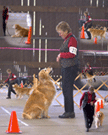How to lay a Beginner Track – Day 1
| When first laying tracks, let your dog watch you by crating him, or tying him to a tree. If you are with another person, that person can hold your dog, but should not distract or talk to the dog. If you are with your instructor, your instructor will lay your track. | |
| Decide where you want to lay a track, which direction you want the track to go. Short field grass or mowed grass is preferred. | Find a place that is open and preferably flat with vegetation that is relatively level. No trees, bushes or fences nearby. If windy, lay the track into the wind. |
| Put start flag into the ground on left side of left foot. Look at the dog, wave article and get the dog's attention on you. Place the start article where you are standing. Look at the dog, wave article and get the dog's attention on you. You will stand at the start for a few seconds. This causes more of your scent to be concentrated at the start. | If your trainer is laying the track and you are near the start with your dog on a leash, make sure you do not talk to the dog at this time. Let the tracklayer get the dog's attention. No corrections or commands. Let the dog be excited about the tracklayer who is getting his attention. |
| Focus on a target in the distance to walk towards. | Target – an object to focus on when laying a track in order to walk straight. Most people tend to list to the right or left. Focusing on a distant target helps you to walk straight. This target will also aid you later when the dog is tracking. Targets can be trees, fence posts, lamp posts, signs, telephone poles, roofs, bushes, tall weeds, flowers, etc. |
| Take one step and drop food in front of your foot. | Food – use very tiny pieces of food (no larger than your small fingernail) and crumbs. For beginners, footsteps can be anywhere from "baby steps" (heel to toe) to a natural step of about 18 inches. |
| Take another step and drop food in front of your foot. | |
| Walk 10 steps towards that target making sure you are walking straight. | Place food drops in front of each foot step. |
| At the end of your track, put a glove in front of you with several treats on/under or inside glove. | |
| Walk through glove and place a final flag 5 steps after glove. Continue to walk straight for about 15 more steps. | Direction of wind helps you to decide the distance you walk after laying the final article. |
| Turn going downwind taking about 15 steps (in mild or no wind) 30 steps (on windy day) | You do not want your scent to be blown towards the track on your return. Do not return upwind. |
| Turn again paralleling the track back and beyond start flag and get your dog. | Read "How to run a Beginner Track – Day 1" |
Tracking – What You Will Need
*A must for beginners
- *Harness
- *Paper & pencil
- *TD - leather glove, leather wallet and a piece of cloth for laying tracks. VST will also include metal & plastic articles.
- *Food (tiny pieces of favorite treats, dry kibble, dry cookies, veggies. I discourage uncooked hot dogs etc. - smelly food attracts bees & ants.
- *6' leash (eventually you will need a 40' line) [1]
- *Water & water dish, use a very small plastic/metal dish (cat dish/camping cup) preferred over folding cloth dish
- *Plastic bags for picking up dog's potty
- Landscaping flags in bright colors at least 30" tall, preferably orange & pink as they show up best in the fields.
- Clothespins with bright colored tape attached (again, preferably pink & orange, white is good too)
- Rain gear for rainy weather
- Waist Pack that can carry 2 waters & tracking line & harness
- Watch
- Small seal-proof container for ticks (with cotton and alcohol inside). This is used when taking ticks off of dogs in parking lots after tracking
- Tweezers – use only if tick cannot be removed by hand
- For tracking in San Francisco Bay Area County Parks [2], it is preferable to use an orange vest purchased at Army Surplus Stores
[1]
Long Lines: A 3/8" climbing rope is good for larger dogs. Have someone
sew a clasp onto one end. A nylon parachute line is good for smaller dogs.
Sew a small clasp onto one end.
[2]
Permission must be given by most County Parks to be off trails.
